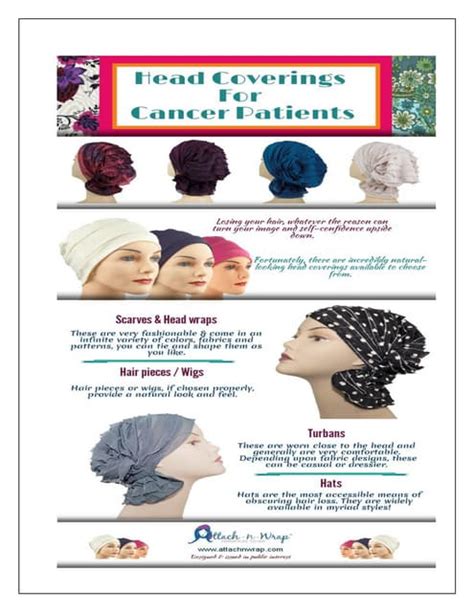Losing hair during cancer treatment can be a challenging experience, both physically and emotionally. Head coverings offer a practical and stylish way for patients to manage this side effect and maintain a sense of normalcy.

Understanding the Benefits of Head Coverings
According to the American Cancer Society, approximately 65% of cancer patients experience hair loss as a result of chemotherapy or radiation therapy. Head coverings can provide the following benefits:
- Protection: Protect the scalp from sun exposure, cold, and other elements.
- Comfort: Reduce skin irritation and itching caused by hair loss.
- Privacy: Allow patients to cover their heads without drawing unwanted attention.
- Psychological support: Boost self-esteem and provide a sense of control during a difficult time.
Types of Head Coverings
There is a wide variety of head coverings available for cancer patients, including:
- Hats: Beanies, scarves, turbans, baseball caps, and other hats offer comfort and coverage.
- Wigs: Synthetic or human hair wigs can provide a realistic and fashionable alternative to natural hair.
- Scarves: Lightweight and versatile, scarves can be worn in various ways to cover the head and neck.
- Caps: Cotton or silk caps can protect the scalp and absorb moisture.
- Headbands: Bandanas, headbands, and hairbands can add a touch of style while keeping the head covered.
Considerations When Choosing
When choosing a head covering, it’s important to consider factors such as:
- Comfort: The material should be soft and comfortable against the scalp.
- Breathability: Choose fabrics that allow for airflow to prevent overheating.
- Style: Select a head covering that fits personal preferences and complements the patient’s wardrobe.
- Convenience: Consider how easy the head covering is to put on and take off, especially for patients with limited mobility.
Creative Solutions for Head Coverings
Beyond traditional options, patients can also explore creative ways to cover their heads, such as:
- Head wraps: Use colorful or patterned fabric to create unique and stylish head wraps.
- Scarf draping: Experiment with different ways to drape scarves to achieve a variety of looks.
- Bandana art: Embellish bandanas with embroidery, beading, or other decorative elements.
- Painted headbands: Paint or decorate headbands with personal designs or inspirational messages.
Resources for Support
Several organizations provide support and resources for cancer patients seeking head coverings, including:
- American Cancer Society: https://www.cancer.org/treatment/treatments-and-side-effects/physical-side-effects/hair-loss/hair-loss-head-coverings.html
- Look Good Feel Better: https://lookgoodfeelbetter.org/
- Cancer Care: https://www.cancercare.org/publications/173-head-coverings
Tips and Tricks
- Use a soft brush or comb: Avoid using harsh brushes or combs on a sensitive scalp.
- Cover the head before bed: Wear a cap or scarf to protect the scalp from friction.
- Avoid tight headbands: Choose headbands that are comfortable and do not restrict blood flow.
- Use sunscreen: Protect the scalp from sun damage by wearing a wide-brimmed hat or applying sunscreen.
- Talk to a stylist: Seek advice from a hairstylist who specializes in hair loss to find the best head covering options.
FAQs
1. Can I wear headscarves after a radiation therapy session?
Yes, headscarves can provide a comfortable and protective barrier against irritation and sensitivity caused by radiation therapy.
2. How often should I wash head coverings?
Head coverings should be washed regularly, especially if they are worn daily. Follow the manufacturer’s instructions for proper washing and care.
3. Can head coverings help prevent hair loss?
While head coverings cannot prevent hair loss caused by cancer treatment, they can protect the scalp and reduce hair breakage.
4. Can I wear wigs during chemotherapy?
Wigs can be worn during chemotherapy, but it’s important to consult with a healthcare professional to determine the best timing and options for wig selection.
5. Are head coverings tax-deductible?
In some cases, head coverings may be tax-deductible as a medical expense. Consult with a tax professional for more information.
6. Can I wear head coverings post-chemotherapy?
Yes, some patients continue to wear head coverings after chemotherapy to protect the scalp from sun damage or other environmental factors.
Tables
Table 1: Types of Head Coverings
| Type | Description |
|---|---|
| Hats | Beanies, scarves, turbans, baseball caps |
| Wigs | Synthetic or human hair alternatives |
| Scarves | Lightweight and versatile fabrics |
| Caps | Cotton or silk protectors |
| Headbands | Bandanas, headbands, hairbands |
Table 2: Considerations When Choosing a Head Covering
| Factor | Description |
|---|---|
| Comfort | Soft and comfortable material |
| Breathability | Allows for airflow |
| Style | Personal preferences and wardrobe fit |
| Convenience | Easy to put on and take off |
Table 3: Creative Solutions for Head Coverings
| Solution | Description |
|---|---|
| Head wraps | Unique and stylish wraps |
| Scarf draping | Experiment with different draping techniques |
| Bandana art | Embellished or painted bandanas |
| Painted headbands | Personal or inspirational designs |
Table 4: Tips and Tricks for Head Coverings
| Tip | Description |
|---|---|
| Use a soft brush | Avoid harsh brushes on sensitive scalps |
| Cover the head before bed | Protect the scalp from friction |
| Avoid tight headbands | Choose comfortable and loose bands |
| Use sunscreen | Protect the scalp from sun damage |
| Talk to a stylist | Seek professional advice for best options |
